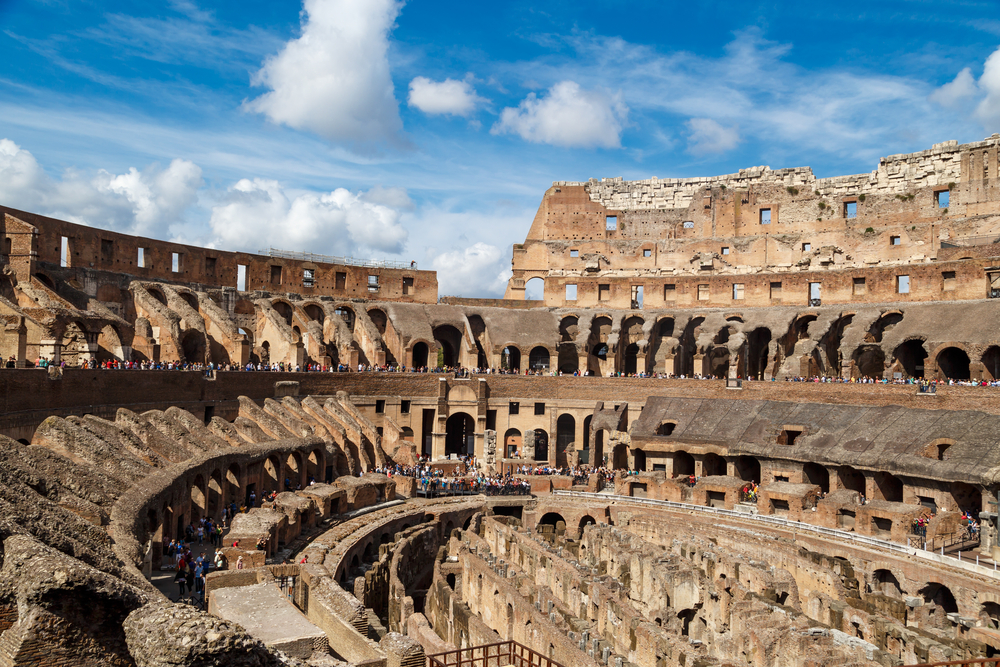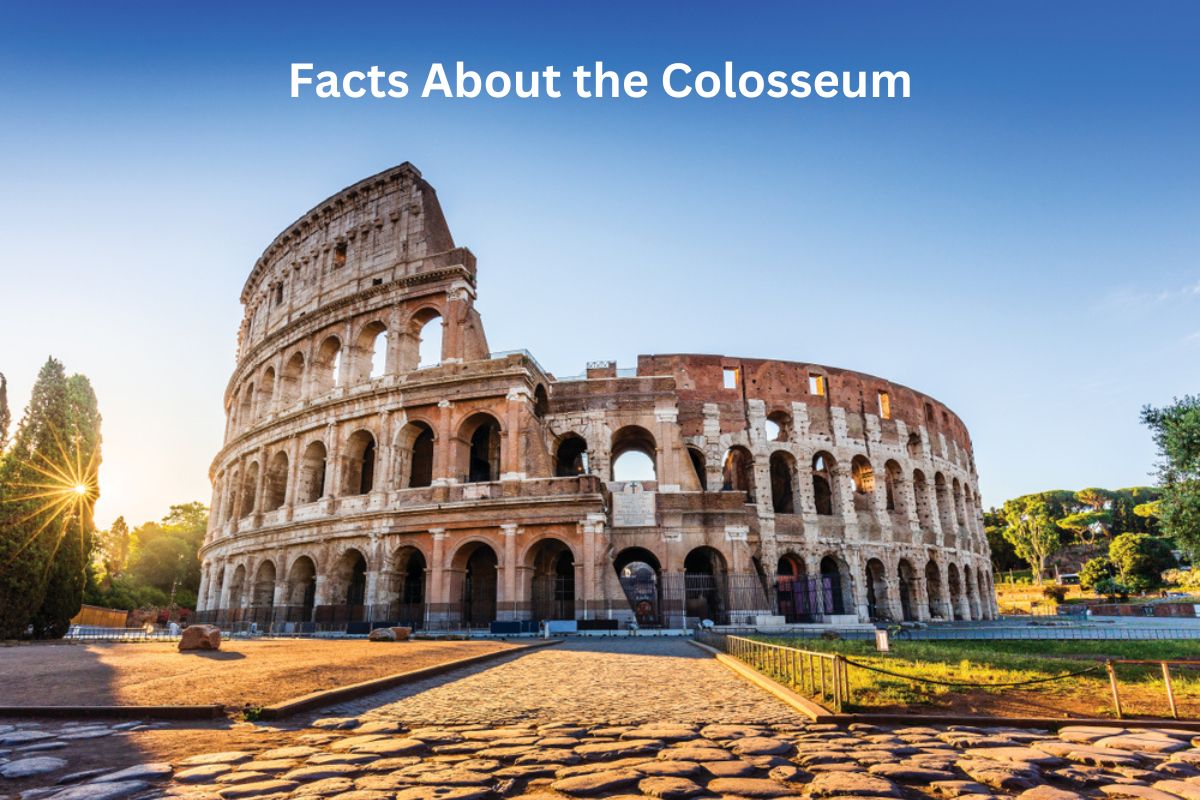The Colosseum, also known as the Flavian Amphitheatre, is an iconic ancient Roman structure located in Rome, Italy. Built during the first century AD, it stands as a testament to the architectural prowess and grandeur of the Roman Empire.
The Colosseum was a magnificent amphitheater primarily used for gladiatorial contests, animal hunts, and other public spectacles, captivating audiences of up to 80,000 spectators.
Its colossal size, impressive architectural design, and historical significance have made it a UNESCO World Heritage Site and a globally recognized symbol of ancient Rome.
The Colosseum Facts
1. Located in Rome, Italy
The Colosseum, located in Rome, Italy, is one of the most iconic and recognizable landmarks in the world. It is situated in the central part of the city, just east of the Roman Forum.
The site’s historical significance and impressive architecture make it a must-visit destination for tourists from around the globe.

2. Construction began in 72 AD and completed in 80 AD
Construction of the Colosseum began in 72 AD during the reign of Emperor Vespasian of the Flavian dynasty. It was a massive undertaking that required skilled architects, engineers, and laborers.
Also Read: Facts About the Pantheon
The project aimed to provide a grand venue for public entertainment and showcase the might and opulence of the Roman Empire.
3. Used for gladiatorial contests and public spectacles
The Colosseum was primarily used for gladiatorial contests, animal hunts, and other public spectacles. These events were a significant part of Roman culture and entertainment, serving as a means of demonstrating power, maintaining social order, and engaging the population.
Also Read: Roman Gladiators Facts
The gladiatorial battles, in particular, were a popular form of entertainment, where trained fighters engaged in combat to the delight of the crowds. The Colosseum’s immense size allowed for large-scale spectacles to be held, attracting thousands of spectators to witness the thrilling shows.
4. Could accommodate 50,000 to 80,000 spectators
The Colosseum could accommodate an estimated 50,000 to 80,000 spectators, making it the largest amphitheater of its time.
The seating arrangement was divided into different sections based on social status, with the most privileged individuals sitting closest to the arena floor.
The seating capacity and tiered arrangement allowed for a clear view of the events taking place in the arena from every angle.
5. Made of travertine stone and concrete
The exterior of the Colosseum is made primarily of travertine stone, a type of limestone, and concrete. The combination of these materials provided both structural stability and aesthetic appeal. The outer façade featured a series of arches and columns, creating a visually striking architectural design.
The lower level of the Colosseum consisted of sturdy Doric columns, followed by the more decorative Ionic columns on the middle level, and finally, the elaborate Corinthian columns on the top level.
6. Stands at a height of 48 meters (157 feet)
The Colosseum, one of the most remarkable architectural marvels of ancient Rome, stands at an impressive height of 48 meters (157 feet). This towering height contributes to its awe-inspiring presence in the cityscape of Rome.
The structure’s immense size and height were a testament to the engineering expertise of the time and served to emphasize the grandeur and magnificence of the Roman Empire.
The towering height of the Colosseum allowed it to dominate the surrounding landscape, showcasing the power and prominence of Rome to all who beheld it. Even today, its vertical stature continues to inspire wonder and admiration among visitors from around the world.

7. Features three different column styles
The exterior of the Colosseum is made primarily of travertine stone, a type of limestone, and concrete. The combination of these materials provided both structural stability and aesthetic appeal. The outer façade featured a series of arches and columns, creating a visually striking architectural design.
The lower level of the Colosseum consisted of sturdy Doric columns, followed by the more decorative Ionic columns on the middle level, and finally, the elaborate Corinthian columns on the top level.
8. Had an arena floor covered with sand and an underground hypogeum
The arena floor of the Colosseum was made of wood and covered with a layer of sand. This sand, known as “harena” in Latin, served multiple purposes. It absorbed blood and other bodily fluids during gladiatorial combat, preventing the surface from becoming too slippery.
Additionally, it provided a naturalistic element for animal hunts, as it mimicked the environment of the wild. Beneath the wooden floor, a vast underground network of chambers and tunnels called the hypogeum existed. These areas were used to house animals, gladiators, and props, pro
9. Symbolized Roman power and grandeur
The Colosseum served as a symbol of Roman power and grandeur. It was a testament to the empire’s architectural and engineering prowess, as well as its ability to organize and host grand events.
The construction and operation of such a monumental structure required vast resources and manpower, emphasizing the wealth and influence of the Roman ruling elite.
The Colosseum became a venue for emperors to display their authority and provide entertainment to the Roman citizens, solidifying their support and reinforcing the social hierarchy.
10. UNESCO World Heritage Site and popular tourist attraction
Over time, the Colosseum endured significant damage due to natural disasters and human activities. Several earthquakes rocked the region, causing partial collapses and structural weakening.
In addition, fires and the looting of its materials, such as marble and metal, further contributed to its deterioration. Despite the damage, the Colosseum remained an enduring symbol of ancient Rome’s glory.
During the medieval period, the Colosseum was repurposed as a fortress by noble families seeking protection. Its sturdy walls and strategic location made it an ideal stronghold. However, this adaptation led to further degradation, as the structure was subjected to alterations and damage during conflicts.
It wasn’t until the 18th century that efforts were made to preserve and restore the Colosseum. The monument’s historical and architectural significance prompted restoration initiatives aimed at stabilizing the structure and protecting it for future generations.
Today, the Colosseum stands as a UNESCO World Heritage Site, recognized for its cultural value and historical importance. It continues to captivate visitors with its grandeur, serving as a tangible link to the ancient Roman civilization and attracting millions of tourists each year. Efforts are ongoing to ensure its preservation and maintain it as a symbol of Rome’s rich history.
